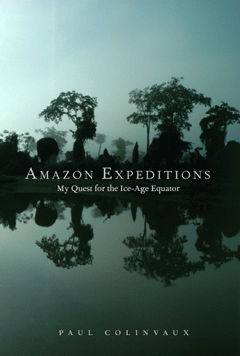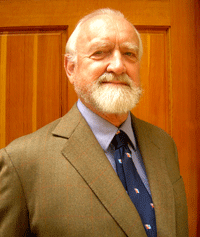Amazon Expeditions
Air Date: Week of April 4, 2008

Ecologist Paul Colinvaux spent forty years traveling along the equator to find out what the region looked like during the Ice Age. Colinvaux searched for ancient lakes and collected pollen and mud from them to find clues. Paul Coinvaux chronicles his journeys in the book “Amazon Expeditions, My Quest for the Ice Age Equator” and talks with host Bruce Gellerman.
Transcript
GELLERMAN: Why are areas by the equator so richly diverse in wildlife, when places in northern climes are so species poor? Well, ecologist Paul Colinvaux spent forty years investigating that question, analyzing core samples of sediment from ancient lakes for clues.
COLINVAUX: Pollen analysis in the Amazon was harder even than finding the ancient lakes. There are 80,000 species of plants known in the Amazon -- 80,000 kinds of pollen.
GELLERMAN: Paul Colinvaux’s search for signs of climate change are chronicled in his new book, “Amazon Expeditions; My Quest for the Ice Age Equator.” It’s sort of Linnaeus meets Indiana Jones. I asked Colinvaux why anyone would spend decades trekking along the equator in search of ancient lakes.
COLINVAUX: Well, my first and original reason is that it might help us understand why there are so many species there. The first, and in those days, still living hypothesis to explain this was that the Ice Ages did it by extincting everything in the North and the equator escaped and it was nice and warm and everything went on as usual and been gathering species forever, but we didn’t know what it was like at the equator in the Ice Age, we just thought it was.
GELLERMAN: Not until you go there. Now, there was something called the Haffer Hypothesis.
COLINVAUX: Yes.
GELLERMAN: Did I pronounce that correctly?
COLINVAUX: That’s correct.
GELLERMAN: So, his hypothesis says that things dried out and that grasses populated the area.
COLINVAUX: Savannas.
GELLERMAN: And that led to the speciation, the evolution of different species.
COLINVAUX: Yes, because there were little patches of forest left where, by some curious accident, he never explained that, the rain kept going and they were an archipelago of refugia.
GELLERMAN: And you found that, over your forty years, that, in fact, not true.
COLINVAUX: Not true.
GELLERMAN: No grasses.
COLINVAUX: No grasses.
GELLERMAN: And the way you did that is by doing these core samples in ancient lakes, looking for pollen.
COLINVAUX: That is correct, looking for pollen because once you’ve got the pollen and a date…I had to get a date of 20,000 years, for instance, because that was the height of the Ice Age, well that’s easy, you do it with radiocarbon. So you say, ‘This bit of mud is Ice Age mud’ and you can extract the pollen from it and the pollen grains are perfectly preserved. You can get 100,000 pollen grains in a cubic centimeter of lake mud. It’s a time machine. I go around calling it my time machine. “Have time machine, will travel,” and that’s my motto. And when the Haffer hypothesis came out, that was perfect for “have time machine, will travel,” because as a hypothesis it was beautiful. It predicted something testable. It said that if you had a time machine and you went to the Amazon in the Ice Ages with your time machine, you would find savanna and no forest. Well, I had a time machine that would do just that but it’s pollen in lake mud. And I did just that and bingo!

Paul Colinvaux. (Photo: Mark Chester)
COLINVAUX: Yes.
GELLERMAN: How do you find an ancient lake? You would think that people would know those.
COLINVAUX: Well, I did it the hard way. In fact, I have a conceit that this was the last of the old time explorers. Now you do it with Google Earth and things like that, and GPS systems and -- I did it by talking to the locals, getting air photos from the military whenever they’d done it, which was not, wasn't all that often. But then you’ve got to get to them and you can’t really know just by looking at them, but I quickly developed a criterium: they must be above rivers.
GELLERMAN: Why is that?
COLINVAUX: Because then the river has never come in and swashed them out.
GELLERMAN: You went to the Galapagos.
COLINVAUX: I went to the Galapagos.
GELLERMAN: 1960...66 I think.
COLINVAUX: 1966. And this was before tourism.
GELLERMAN: You discovered an ancient lake.
COLINVAUX: Yes, which was unknown to geography, and it’s a beautiful fresh water lake. I did the chemistry of its water, it’s the same as rainwater. Just lovely, you can drink it straight up. And it’s sitting on top of a mountain, under permanent cloud.
GELLERMAN: In the Galapagos, you also discovered a plant.
COLINVAUX: Oh, yes.
GELLERMAN: It’s named after you.
COLINVAUX: Passionflora Colinvauxiae. Yes, it’s one that Darwin missed.
GELLERMAN: I think it’s very interesting that it’s a passion flower, because you’re a passionate man.
COLINVAUX: Well, that’s kind, yes.
GELLERMAN: But I’m saying, how many other people do you know, who would spend forty years trekking through the equatorial regions in search of ancient lakes and pollen from an Ice Age?
COLINVAUX: There aren’t any.
GELLERMAN: Your work shows that the core samples that you’ve collected over these many years don’t show an increase in grass pollen during the Ice Age.
COLINVAUX: Correct.
GELLERMAN: So now, after the end of a 40-year career investigating this, trekking through thick and thin, aren’t you a little, well, disappointed that you don’t have an answer to replace this hypothesis?
COLINVAUX: Well, I would like to have another 40 years. I rather suspect the good God’s not going to give it to me. Perhaps because I’m an atheist like most biologists with sense.
GELLERMAN: Well, professor, thank you for coming by. I really appreciate it.
COLINVAUX: Thank you.
GELLERMAN: Paul Colinvaux is senior research scientist at Marine Biological Laboratory at Woods Hole, and professor emeritus at the Ohio State University. His new book is called "Amazon Expeditions: My Quest for the Ice Age Equator."
Living on Earth wants to hear from you!
Living on Earth
62 Calef Highway, Suite 212
Lee, NH 03861
Telephone: 617-287-4121
E-mail: comments@loe.org
Newsletter [Click here]
Donate to Living on Earth!
Living on Earth is an independent media program and relies entirely on contributions from listeners and institutions supporting public service. Please donate now to preserve an independent environmental voice.
NewsletterLiving on Earth offers a weekly delivery of the show's rundown to your mailbox. Sign up for our newsletter today!
 Sailors For The Sea: Be the change you want to sea.
Sailors For The Sea: Be the change you want to sea.
 The Grantham Foundation for the Protection of the Environment: Committed to protecting and improving the health of the global environment.
The Grantham Foundation for the Protection of the Environment: Committed to protecting and improving the health of the global environment.
 Contribute to Living on Earth and receive, as our gift to you, an archival print of one of Mark Seth Lender's extraordinary wildlife photographs. Follow the link to see Mark's current collection of photographs.
Contribute to Living on Earth and receive, as our gift to you, an archival print of one of Mark Seth Lender's extraordinary wildlife photographs. Follow the link to see Mark's current collection of photographs.
 Buy a signed copy of Mark Seth Lender's book Smeagull the Seagull & support Living on Earth
Buy a signed copy of Mark Seth Lender's book Smeagull the Seagull & support Living on Earth

